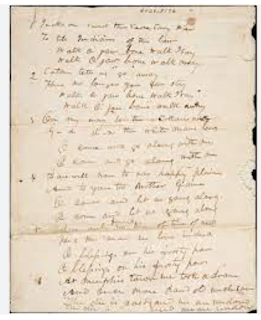In the winter of 1831, the Choctaw Indians were forced out at gunpoint to walk barefoot and in thin clothing from their homelands, 11 million acres in what is now Louisiana, Alabama, Mississippi, and Arkansas, to the Indian Territory in what is now southeast Oklahoma. There are historical accounts of the privation, suffering, and extreme cruelty, but I did not realize that anyone who made the terrible journey had written a song or a poem.
The Gilcrease Museum (located in Tulsa, Oklahoma), actually has a document written by an unnamed author about the removal. It appears on the Choctaw Nation website: https://www.choctawnation.com/biskinik/a-trail-of-tears-song-the-new-jaw-bone/
Poem
1. Jackson send the Secretary War
To the Indians of the law
Walk o jaw bone walk I say
Walk o jaw bone walk away.
2. Eaton tells us go away
Here no longer you can stay
Walk o jaw bone walk I say
Walk o jaw bone walk away
3. On my way to the Arkansas
G_d d__n the white man’s laws
O come and go along with me
O come and go along with me
 |
| The manuscript of the poem by an unnamed Choctaw author |
Until today, I did not realize that there was a second Choctaw Removal. It took place in 1903, and coincided with the dissolution of the Choctaw Nation. In it, Choctaws were sent by train to Ardmore, Oklahoma, which was in the Choctaw Nation. The way they were transported was brutal – they were loaded like cattle onto box cars, and when they arrived in Ardmore, they were imprisoned in a warehouse, where there was no ventilation, sanitation, heat, or adequate food (https://choctawnationculture.com/media/40683/2017.12_the_last_choctaw_removal_-_ardmore.pdf). Some were then shipped out to different farms and locations where they had to work for a place to sleep. Others were given allotments of land that had no water or arable land. Some stayed in Ardmore, living in abject destitution.
My mother was born in Ardmore in 1932. My grandmother had lived in that town, staring in the late 1920s, and I remember her telling me that the way the Choctaw Indians had to live was worse than criminal. In addition to a lack of food and water, the Mississippi Choctaws suffered from outbreaks of disease. Despite the desperate poverty, the Choctaws pulled together the best they could and preserved their dress, songs, beliefs and culture. Here is a link to Choctaw tribal members wearing traditional outfits: https://www.choctawnation.com/about/culture/traditions/dress/
Lesa Phillips Roberts (1889 – 1994) was a very Choctaw girl who survived the Second Removal from Mississippi to Oklahoma. She ended up in Atoka, Oklahoma, where life was very precarious. The Mississippi Choctaws were given allotments of land, but they were often in undesirable areas, and the Choctaws already in Oklahoma were often placed in conflict with them. Her life story was captured by her son, Charles Roberts, near the end of her life. It was published in The American Indian Quarterly in 1990 in an article entitled “A Choctaw Odyssey, The Life of Lesa Phillip Roberts.”
The Choctaw Nation Cultural Center is located in Calera, Oklahoma, near the town of Durant. Durant is a regional center with a four-year university (Southeast Oklahoma State University), Choctaw business enterprises (casino, food products), and the Choctaw Nation Tribal Complex.